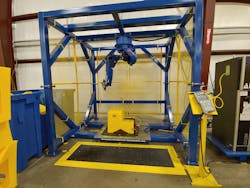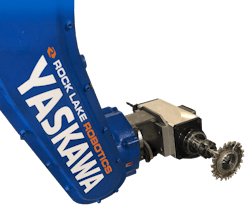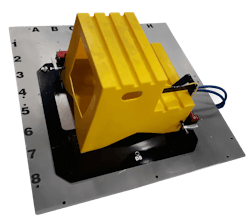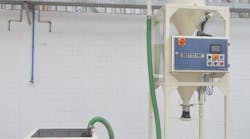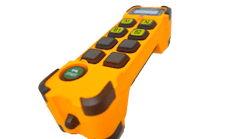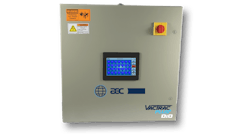Problem: Workers at a rotomolding company were manually cutting some products, which resulted in inconsistent cuts and exposed workers to safety hazards.
Solution: The company installed a cutting robot with fixtures built to secure hard-to-trim parts, which resulted in perfect cuts every time.
Saws and routers are indispensable tools for many rotomolding companies that have to put finishing touches on some products before shipping them. But it’s becoming more difficult to hire workers who can skillfully handle these tools, which can lead to safety hazards for inexperienced employees and growing scrap rates for companies.
“The main reasons we bought the robot was for safety, consistency and efficiency,” Wallace said. “Some of the parts we make are awkward to trim. Anytime you have a human operator using a router, it can get away from you. Not everybody is good with a router or saw. We run a high volume, about 200 parts a day, so there also can be an operator fatigue factor.”
DPI has about 55 employees and operates two 10-hour shifts four days a week. It has 12 rotomolders that make an assortment of products, including materials-handling carts, utility carts, steps, bulk containers, dumpsters, commercial recycling containers, drums and nesting totes.
The company’s industrial steps and a feeder for cattle proved especially difficult to trim consistently by hand. Every product that is cut by the robot needs to be held in place by a fixture, also was designed by RLR.
“The feeder is an oval shape, which is not an easy trim,” Wallace said. “Now we just move it from the rotomolder, set it in the fixture, hit a button, it clamps the part down and trims the part automatically and releases the part.”
Each trim is done quickly and perfectly without putting any employees at risk, he said.
The cage that contains the robot includes a safety gate, so operators can’t accidentally put themselves in harm’s way.
“If an operator gets too close to the robot, it will automatically shut off,” he said. “While it is trimming the part, the operator can go do something else. They don’t have to stand there and watch it, so it improves efficiency. We’ve run thousands of parts and haven’t had any problems.”
RLR was born out of the needs of the rotational molding industry.
The owners of Seljan Co., a large rotational molding contract manufacturer in Lake Mills, Wis., launched RLR to supply finishing robots for the company’s rotational molding department.
“We started about five years ago because we realized we had a lot of low-hanging fruit in the rotational molding division of Seljan,” said Dru Laws, senior VP of both Seljan and RLR. “We focused almost exclusively on automating secondary operations for Seljan’s rotomolding division. That led to Rock Lake Robotics offering automation solutions outside of Seljan to the rotomolding industry.”
Laws, who also is the president of the Association of Rotational Molders, gave a presentation at an industry trade event in 2017 about Seljan’s journey into automation. A DPI employee attended the presentation and reached out to Laws after the meeting, which led to the robot installation at DPI.
The Yaskawa robot installed at DPI is not a customized robot, Laws said, but the fixtures that hold the products in place and the programming that controls the robot’s precise movements are customized. RLR designed and built two fixtures to hold the industrial steps and cattle feeder in place so the robot can cut them.
The six-axis robot can get around the entire part and trim it in one setup, according to Sam Scott, automation engineer for RLR.
“We use a double-ended spindle on the end of the robot, Scott said. “If they want to switch from a cutting router to a saw blade, they can do that by rotating the arm, which eliminates a step. The variable-frequency drive is fully integrated into the control cabinet. We can reverse-mode or do different flute cuts, or different speeds, depending on the part thickness and material.” The robot’s end-of-arm tooling can accommodate both the router and the saw, so both tools can be used to trim a single part.
Scott said the standard lead time is about 14 to 16 weeks to build a fixture and program the robot. He requests CAD files of the part to be trimmed and he needs to have the finished part both cut and uncut to design the fixture and program the robot’s path. He built two fixtures for DPI — one to hold two different sizes of steps, and another to hold the feeder.
The installation of the robot at DPI took only about 45 minutes and training was completed in the same day, according to Scott. The robot is designed so it can be moved by a forklift. Training was simple because it is a plug-and-play product.
Wallace agreed with Scott about the robot’s ease of use. “On-site training was done in less than one day,” Wallace said. “It’s easy to switch from trimming one part to another. You just hit a few buttons.”
RLR, an authorized Yaskawa reseller through Motoman Robotics, continues to focus on offering affordable robots for trimming parts.
“We get phone calls asking for complicated solutions, but that is not our best fit,” Laws said. “We target low-hanging fruit with simple solutions. DPI’s volumes were high, and their product was simple. It was a home run for both companies.”
Bruce Adams, senior staff reporter
Contact
Rock Lake Robotics, Lake Mills, Wis., 920-648-3402, www.rocklakerobotics.com
